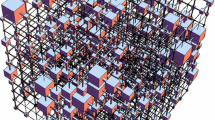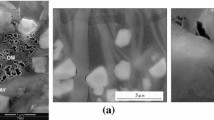Abstract
The state of the art of modeling fluid flow in shale reservoirs is dominated by dual-porosity models which divide the reservoirs into matrix blocks that significantly contribute to fluid storage and fracture networks which principally control flow capacity. However, recent extensive microscopic studies reveal that there exist massive micro- and nano-pore systems in shale matrices. Because of this, the actual flow mechanisms in shale reservoirs are considerably more complex than can be simulated by the conventional dual-porosity models and Darcy’s law. Therefore, a model capturing multiple pore scales and flow can provide a better understanding of the complex flow mechanisms occurring in these reservoirs. This paper presents a micro-scale multiple-porosity model for fluid flow in shale reservoirs by capturing the dynamics occurring in three porosity systems: inorganic matter, organic matter (mainly kerogen), and natural fractures. Inorganic and organic portions of shale matrix are treated as sub-blocks with different attributes, such as wettability and pore structures. In kerogen, gas desorption and diffusion are the dominant physics. Since the flow regimes are sensitive to pore size, the effects of nano-pores and micro-pores in kerogen are incorporated into the simulator. The multiple-porosity model is built upon a unique tool for simulating general multiple-porosity systems in which several porosity systems may be tied to each other through arbitrary connectivities. This new model allows us to better understand complex flow mechanisms and eventually is extended into the reservoir scale through upscaling techniques. Sensitivity studies on the contributions of the different flow mechanisms and kerogen properties give some insight as to their importance. Results also include a comparison of the conventional dual-porosity treatment and show that significant differences in fluid distributions and dynamics are obtained with the improved multiple-porosity simulation.
Similar content being viewed by others
References
Aguilera, R.: Incorporating capillary pressure, pore throat aperture radii, height above free-water table, and Winland r35 values on Pickett plots. AAPG Bull. 86(4), 605–624 (2002)
Alfi, M., Yan, B., Cao, Y., et al.: Three-phase flow simulation in ultra-low permeability organic shale via a multiple permeability approach. Soc. Pet. Eng. (2014). doi:10.15530/urtec-2014-1895733
Ambrose, R.J., Hartman, R.C., Diaz-Campos, M., et al.: Shale gas-in-place calculations part I: new pore-scale considerations. (2012). doi:10.2118/131772-PA
Andrade, J., Civan, F., Devegowda, D., et al.: Design and examination of requirements for a rigorous shale-gas reservoir simulator compared to current shale-gas simulator. Paper presented at the North American Unconventional Gas Conference and Exhibition. The Woodlands, Society of Petroleum Engineers SPE-144401-MS. (2011). doi:10.2118/144401-ms
Beskok, A., Karniadakis, G.E.: A model for flows in channels, pipes, and ducts at micro and nano scales. Microscale Thermophys. Eng. 3(1), 43–77 (1999)
Civan, F.: Effective correlation of apparent gas permeability in tight porous media. Transp. Porous Media 82 (2), 375–384 (2010). doi:10.1007/s11242-009-9432-z
Civan, F., Rai, C., Sondergeld, C.: Shale-gas permeability and diffusivity inferred by improved formulation of relevant retention and transport mechanisms. Transp. Porous Media 86(3), 925–944 (2011). doi:10.1007/s11242-010-9665-x
Clarkson, C.R., Ertekin, T.: A new model for shale gas matrix flow using the dynamic-slippage concept. Paper presented at the AAPG Hedberg Conference, Austin, Texas (2010)
Cui, X., Bustin, A.M.M., Bustin, R.M.: Measurements of gas permeability and diffusivity of tight reservoir rocks: different approaches and their applications. Geofluids 9(3), 208–223 (2009). doi:10.1111/j.1468-8123.2009.00244.x
Curtis, M.E., Ambrose, R.J., Sondergeld, C.H.: Structural characterization of gas shales on the micro- and nano-scales. Paper presented at the Canadian Unconventional Resources and International Petroleum Conference, Calgary, Alberta, Canada. Society of Petroleum Engineers SPE-137693-MS. (2010). doi:10.2118/137693-ms
Curtis, M.E., Sondergeld, C.H., Ambrose, R.J., et al.: Microstructural investigation of gas shales in two and three dimensions using nanometer-scale resolution imaging. AAPG Bull. 96(4), 665–677 (2012). doi:10.1306/08151110188
Ding, D.Y., Langouët, H., Jeannin, L.: Simulation of fracturing-induced formation damage and gas production from fractured wells in tight gas reservoirs. (2013). doi:10.2118/153255-PA
Ding, D.Y., Wu, Y.S., Jeannin, L.: Efficient simulation of hydraulic fractured wells in unconventional reservoirs. J. Pet. Sci. Eng. 122, 631–642 (2014). doi:10.1016/j.petrol.2014.09.005
Ertekin, T., King, G.A., Schwerer, F.C.: Dynamic gas slippage: a unique dual-mechanism approach to the flow of gas in tight formations. SPE Form. Eval. 1(1), 43–52 (1986). doi:10.2118/12045-pa
Freeman, C., Moridis, G.J., Michael, G.E., et al.: Measurement, modeling, and diagnostics of flowing gas composition changes in shale gas wells. Paper presented at the SPE Latin America and Caribbean Petroleum Engineering Conference, Mexico City, Mexico. Society of Petroleum Engineers SPE-153391-MS. (2012). doi:10.2118/153391-ms
Furui, K., Zhu, D., Hill, A.D.: A rigorous formation damage skin factor and reservoir inflow model for a horizontal well. Society of Petroleum Engineers. (2002). doi:10.2118/74698-MS
Gilman, J.R.: An efficient finite-difference method for simulating phase segregation in the matrix blocks in double-porosity reservoirs. SPE Reserv. Eng. 1(4), 403–413 (1986). doi:10.2118/12271-pa
Hill, D.G., Nelson, C.R.: Gas productive fractured shales—an overview and update. Gas TIPS, pp. 4–13 (2000)
Hoteit, H., Firoozabadi, A.: Numerical modeling of diffusion in fractured media for gas injection and recycling schemes. Paper presented at the SPE Annual Technical Conference and Exhibition, San Antonio, Texas, USA. Society of Petroleum Engineers SPE-103292-MS. (2006). doi:10.2118/103292-ms
Hudson, J.D., Civan, F., Michel, G., et al.: Modeling multiple-porosity transport in gas-bearing shale formations. Paper presented at the SPE Latin America and Caribbean Petroleum Engineering Conference, Mexico City, Mexico. Society of Petroleum Engineers SPE-153535-MS. (2012). doi:10.2118/153535-ms
Jarvie, D.: Evaluation of hydrocarbon generation and storage in Barnett Shale, Fort Worth Basin, Texas. Paper presented at the Petroleum Technology Transfer Council. The University of Texas at Austin, Bureau of Economic Geology (2004)
Javadpour, F.: Nanopores and apparent permeability of gas flow in mudrocks (shales and siltstone). J. Can. Pet. Technol. 48(08), 16–21 (2009)
Javadpour, F., Fisher, D., Unsworth, M.: Nanoscale gas flow in shale gas sediments. J. Can. Pet. Technol. 46(10) (2007). doi:10.2118/07-10-06
King, G.E.: Thirty years of gas shale fracturing: What have we learned? Paper presented at the SPE annual technical conference and exhibition, Florence, Italy. Society of Petroleum Engineers SPE-133456-MS (2010). doi:10.2118/133456-ms
Lim, K.T., Aziz, K.: Matrix-fracture transfer shape factors for dual-porosity simulators. J. Pet. Sci. Eng. 13(3–4), 169–178 (1995). doi:10.1016/0920-4105(95)00010-F
Loucks, R.G., Reed, R.M., Ruppel, S.C., et al.: Spectrum of pore types and networks in mudrocks and a descriptive classification for matrix-related mudrock pores. AAPG Bull. 96(6), 1071–1098 (2012). doi:10.1306/08171111061
Lu, H.: Investigation of recovery mechanisms in fractured reservoirs. PhD Dissertation, Imperial College (2007)
Luo, H.-S., Wang, X.-H., Quintard, M.: Adaptive mesh refinement for one-dimensional three-phase flows in heterogeneous fractured porous media. Numerical Heat Transfer, Part B: Fundamentals 54(6), 476–498 (2008). doi:10.1080/10407790802424105
Mora, C.A.: Comparison of Computation methods for CBM production performance. Master of Science Thesis, Texas A&M University (2007)
Nœtinger, B.: A quasi steady state method for solving transient Darcy flow in complex 3d fractured networks accounting for matrix to fracture flow. J. Comput. Phys. 283, 205–223 (2015). doi:10.1016/j.jcp.2014.11.038
Odusina, E.O., Sondergeld, C.H., Rai, C.S.: An NMR study of shale wettability. Paper presented at the Canadian Unconventional Resources Conference, Alberta, Canada. Society of Petroleum Engineers SPE-147371-MS. (2011). doi:10.2118/147371-ms
Passey, Q.R., Bohacs, K., Esch, W.L., et al.: From oil-prone source rock to gas-producing shale reservoir—geologic and petrophysical characterization of unconventional shale-gas reservoirs. Paper presented at the International Oil and Gas Conference and Exhibition in China, Beijing, China. Society of Petroleum Engineers SPE-131350-MS. (2010). doi:10.2118/131350-ms
Pruess, K.: GMINC—a mesh generator for flow simulations in fractured reservoirs (1982)
Pruess, K.: A practical method for modeling fluid and heat flow in fractured porous media. Soc. Pet. Eng. J. 25(1), 14–26 (1985). doi:10.2118/10509-pa
Shabro, V., Torres-Verdin, C., Javadpour, F.: Numerical simulation of shale-gas production: from pore-scale modeling of slip-flow, Knudsen diffusion, and Langmuir desorption to reservoir modeling of compressible fluid. Paper presented at the North American Unconventional Gas Conference and Exhibition, The Woodlands, Texas, USA. Society of Petroleum Engineers SPE-144355-MS. (2011). doi:10.2118/144355-ms
Shabro, V., Torres-Verdin, C., Sepehrnoori, K.: Forecasting gas production in organic shale with the combined numerical simulation of gas diffusion in kerogen, Langmuir desorption from kerogen surfaces, and advection in nanopores. Paper presented at the SPE Annual Technical Conference and Exhibition, San Antonio, Texas, USA. Society of Petroleum Engineers SPE-159250-MS. (2012). doi:10.2118/159250-ms
Sigal, R.: A note on the intrinsic porosity of organic material in shale gas reservoir rocks. http://shale.ou.edu/Home/Publication (2011)
Sun, J., Hu, K., Wong, J., et al.: Investigating the effect of improved fracture conductivity on production performance of hydraulic fractured wells through field case studies and numerical simulations. Society of Petroleum Engineers. (2014). doi:10.2118/169866-MS
Sun, J., Schechter, D.S.: Optimization-based unstructured meshing algorithms for simulation of hydraulically and naturally fractured reservoirs with variable distribution of fracture aperture, spacing, length and strike. Society of Petroleum Engineers. (2014). doi:10.2118/170703-MS
Swami, V., Clarkson, C.R., Settari, A.: Non-Darcy flow in shale nanopores: do we have a final answer? Society of Petroleum Engineers. (2012). doi:10.2118/162665-MS
Wang, F.P., Reed, R.M.: Pore networks and fluid flow in gas shales. Paper presented at the SPE Annual Technical Conference and Exhibition, New Orleans, Louisiana. Society of Petroleum Engineers SPE-124253-MS. (2009). doi:10.2118/124253-ms
Wu, Y.-S., Li, J., Ding, D., et al.: A generalized framework model for the simulation of gas production in unconventional gas reservoirs. (2014). doi:10.2118/163609-PA
Zhang, J., Kamenov, A., Hill, A.D., et al.: Laboratory measurement of hydraulic-fracture conductivities in the Barnett Shale. (2014). doi:10.2118/163839-PA
Zhang, J., Ouyang, L., Hill, A.D., et al.: Experimental and numerical studies of reduced fracture conductivity due to proppant embedment in shale reservoirs. Society of Petroleum Engineers. (2014). doi:10.2118/170775-MS
Zhang, J., Zhu, D., Hill, A.D.: Water-induced fracture conductivity damage in shale formations. Society of Petroleum Engineers. (2015). doi:10.2118/173346-MS
Ziarani, A., Aguilera, R.: Knudsen’s permeability correction for tight porous media. Transp. Porous Media 91(1), 239–260 (2012). doi:10.1007/s11242-011-9842-6
Author information
Authors and Affiliations
Corresponding author
Rights and permissions
About this article
Cite this article
Yan, B., Wang, Y. & Killough, J.E. Beyond dual-porosity modeling for the simulation of complex flow mechanisms in shale reservoirs. Comput Geosci 20, 69–91 (2016). https://doi.org/10.1007/s10596-015-9548-x
Received:
Accepted:
Published:
Issue Date:
DOI: https://doi.org/10.1007/s10596-015-9548-x




